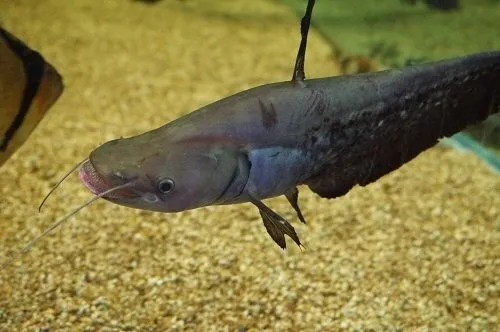
Size
A fully mature specimen may measure 2 meters (6 feet, 7 inches) in length and weigh 150 kilograms (330 lb).
Physical Characteristics and Behavior
The caudal fin is forked, and the anal fin is almost as long as the tail. The fish has a long, broad tail and a short, rounded body. The fish has short pelvic fins and no dorsal spines. The Wallago leerii’s dorsal fin is plain and virtually round, and it has a noticeable bump on its back. This fish has a big, broad head and a huge lower jaw that extends well over its maxilla. Catfish may grab their prey with the help of the numerous sharp teeth that line their mouths. Its primary prey, as a piscivore, is small fish that are captured in mid-swim and consumed whole.
Keeping and Care as Pet

- Water Conditions
The river systems of Thailand, the Malayan peninsula, and the Indonesian islands of Sumatra and Borneo are all included in its native range. The ideal water parameters are 72 to 78 degrees Fahrenheit (22 to 26 degrees Celsius), a pH of 6.0 to 7.0, and a maximum hydrogen carbonate hardness of 20 degrees (H2CO3).
- The Aquarium Size
Really, only the largest public aquariums would be a good fit.
- Maintenance
In a hypothetical situation, décor is unlikely to be important because it would very certainly be destroyed or constantly tossed around. The best option is definitely a tank that is empty, possibly with a gravel substrate. An enormous, extremely effective filtering system would be necessary for a predatory fish of this scale to handle the tremendous amounts of organic waste. In nature, the species has been known to traverse brief stretches of land in search of freshwater, so it stands to reason that a hefty, snug-fitting cover would also be necessary.
- Diet
W. leerii, like other members of its genus, is a fierce predator. Freshwater prawns and smaller fish, including Puntius sp. and bagrid catfish, have also been found in the stomachs of wild animals, according to stomach investigations. In captivity, it probably needs a diet high in meat. The meat of mammals, such as chicken or cow heart, should not be offered to this species. These meats’ fats cannot be adequately metabolized by fish, which might result in excessive fat accumulation and even organ deterioration. While the majority can be trained to accept dead fish over time, some imported specimens initially only eat live fish. As a young animal, it can be fed every day, but as it grows older, one meal per week should be adequate.
- Behavior and Compatibility
To attempt to keep one of them alongside anything else would undoubtedly be a poor idea. While larger tank mates may initially avoid predation, they will inevitably become food at some point.
Table





